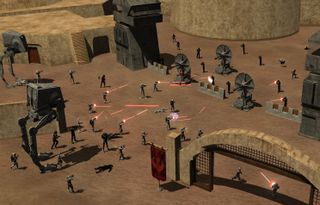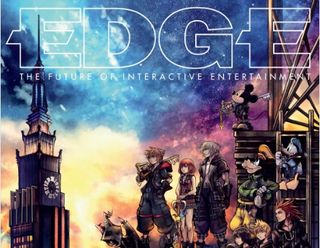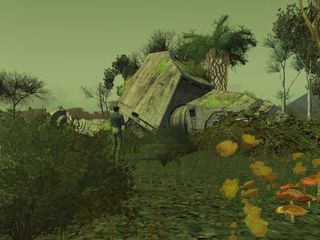Star Wars Galaxies was an MMO that almost changed the world
The rise and fall of an MMO with limitless potential.


The authority on videogame art, design and play, Edge is the must-have companion for game industry professionals, aspiring game-makers and super-committed hobbyists. You can subscribe to both the print or digital editions here.
This article was originally published in issue 278 of Edge, back in March 2015. For more great features like this, you can subscribe here.
The game’s scope could belong to an unlikely sounding Kickstarter pitch, so perhaps it’s little wonder that Sony Online Entertainment shuttered its Star Wars MMOG in December 2011. In its final form, Star Wars Galaxies was a mess of contradictory creative urges whose design and technological foundations had been stripped out from under it—but it was an ambitious mess, the type of game that players often ask for but rarely get.
Galaxies’ creative director, Raph Koster, had been a lead designer on Ultima Online. In the view of Koster and his team, an MMOG was a persistent world driven by systems that emphasised player participation at every level. If the player wanted to be an adventurer, the logic went, then they should be an adventurer in an ecosystem that also included craftsmen, doctors, dancers, pilots and farmers. If an aspiring Han Solo wanted a drink, then they should be able to buy one from a player who—for whatever reason—aspired to be that bartender from the Mos Eisley cantina.
It was a less strange fit for the Star Wars licence than you might think. The game’s development overlapped with the early part of the prequel trilogy, and its developers had chosen to set the game in the period between A New Hope and The Empire Strikes Back. Star Wars Galaxies was, then, far more influenced by the work done in Star Wars’ expanded universe through the ’80s and ’90s than it was by the new films being produced by Lucasfilm.
It has a place in a line of Star Wars work that begins with the original trilogy and extends through novels by authors such as Timothy Zahn and Michael Stackpole, the Dark Horse comics, and simulator-style games such as X-Wing Vs TIE Fighter. The expanded universe treated Star Wars as a world with depth upon which the original films had only touched. It was an ideal fit for the type of MMOG that Koster and the Galaxies team set out to make.
When the game launched in 2003, creating a character meant entering a complex simulation. Your choice of race, for example, determined which languages your character could speak. The majority spoke Basic (see also: English) plus one other language specific to them, while Wookiees could speak only Shyriiwook (see also: Chewbacca). Each language constituted two different skills—listening and speaking—and players could teach these skills to one another. Language spread like a virus: wookiees picked up an understanding of Basic from humans, who might in turn learn to speak Twi’lek or Huttese. Roleplay, community and play merged in a single system—a good metaphor for Star Wars Galaxies’ broader ambitions.

Instead of classes, Star Wars Galaxies gave each character a budget of skill points to spend on professions that could be freely mixed and matched in whole or in part. Interdependency between players was encouraged. Light injuries would heal over time, but more serious wounds would not. These would require the attention of a player medic, often found in medical centres where they received a bonus for their work. Similarly, you might choose to buff your stat pools with food created by a chef or go to a cantina, where player musicians and dancers could offer buffs to experience gain.
The biggest gaming news, reviews and hardware deals
Keep up to date with the most important stories and the best deals, as picked by the PC Gamer team.
When it worked, this created a wonderful sense of place. Players came up with get-rich-quick schemes for themselves or took up jobs to pay the bills on their way to something else. You might start a mining company just to save enough money for an expensive off-world shuttle, and once on that other world you might decide to settle down and never come back. If you were looking for a new blaster, you would scan listings for advertisements from players, journey to their shops in player-built cities, and buy what you wanted from customised NPCs in buildings that had been decorated through an elaborate object manipulation system (with the help of player architects and interior designers, naturally).
When it did not work, in those early days, it was because of balance problems. A niche combat discipline, Teräs Käsi, was discovered to be much more powerful than any other way to play. It was a form of Star Wars kung fu invented for a fighting game on the original PlayStation and, through developer oversight, it came to define early Star Wars Galaxies. Roleplayers inclined to play the game ‘as intended’ struggled in the new ecosystem, which was defined by space karate. Doctors, realising their clientele were in a hurry, relocated to areas outside of starports on hub worlds.
You have to understand Star Wars Galaxies both in terms of what it could be and what it frequently was. What it could be was a game where evocative Star Wars narratives were generated on the fly by a complex set of social systems. What it frequently was was a game where players in identical armour holding knuckle dusters queued for buffs from a man in a coat in the rain.
Jedi would be powerful but hunted by the Empire, and if they died, they’d die forever. On paper, this was a challenging, exciting system, one designed to create extraordinary experiences both for the player that becomes a Jedi and the ones who witness or hunt them.
SOE should have learned from this that balance was uniquely important to Galaxies. It did not. Under pressure from both players and LucasArts to give Jedi a more prominent place in the game, the studio began to take the lid off the game’s elusive Force Sensitive system. The idea was, originally, quite a good one. The game was set at a time when the Jedi were dead or gone, but when new Force sensitives might nonetheless be born. To simulate that, every character was assigned an invisible set of criteria involving multiple profession masteries that ultimately unlocked a Jedi character slot. Jedi would be powerful but hunted by the Empire, and if they died, they’d die forever. On paper, this was a challenging, exciting system, one designed to create extraordinary experiences both for the player that becomes a Jedi and the ones who witness or hunt them.
Almost no Jedi emerged from the system in the early months. To accelerate the process, SOE added a rare item to the game called a holocron, which, once used, would tell you a profession you needed to master to earn your Jedi. Master that profession and use another holocron and it’d tell you the next one, and so on. The impact would subsequently be known as the ‘hologrind’, a social crisis of such scope the game never recovered.
SOE had breached one of the core tenets of Star Wars Galaxies’ original design by placing a singular goal on top of a system defined by lateral interdependencies. The result was chaos. The only items of any worth in the economy became gear for fast levelling and holocrons themselves. Shops were abandoned as armoursmiths rerolled as dancers, dancers rerolled as biotechnicians, biotechnicians rerolled as smugglers. A small underground of hologrind objectors clung on, making money from the chaos in service economies and wondering when the game would become about something other than unlocking Jedi.

To curtail the hologrind, SOE introduced a new Force sensitivity system that hewed much closer to what other MMOGs were doing at the time. It was, functionally, an alternate advancement system based on building reputation with a particular faction, unlocked by following a linear questline. Force sensitivity became accessible to the point of being normal and expected. In fixing the hologrind, something integral about both the game’s design and its fiction had been lost.
A highlight of this time was the launch of Jump To Lightspeed, the game’s first expansion. This introduced space travel—although atmospheric flight was not added until later—and surprisingly adept space combat. It was atmospheric and detailed, and were it not for the Jedi crisis, its release would have marked the game’s peak. As it was, it was a welcome diversion after a long period of uncertainty, and proof some of the ambition of the original design remained.
As the game’s end came into view, a number of community projects sprang up to rescue it. SWGEmu is an emulation project that allows users to run servers using modified versions of the game, typically from before the Combat Upgrade. Others, like ProjectSWG, take the game as it was preNGE. These are small communities and, with limited official support, large parts of the game have been redeveloped from scratch. The servers exist in a legal grey area, too, with uncertainty created by SOE’s recent sale and rebranding. Nonetheless, these efforts are a sign of how passionate the original Galaxies community was—and how far some are willing to go to save the game they loved.
Star Wars was changing, however, and so was the MMOG market. As the prequel trilogy progressed, LucasArts came to perceive the series in terms of iconic images and archetypal situations. Meanwhile, World Of Warcraft proved players wanted authored content from MMOGs. These two ideas would later find each other more naturally in Star Wars: The Old Republic. For Galaxies, they were a crippling imposition.
The first major shift was the Combat Upgrade, which simplified and rebalanced parts of the combat system. It was a success in several ways—karate was no longer preeminent—but a shock to players. Then, months later, the Combat Upgrade itself was thrown out and replaced by New Game Enhancements. Galaxies’ skill system was stripped out and replaced by World Of Warcraft-style classes, chosen during a tutorial mission where you met Han Solo. In a final, sad admission of the failure of the game’s loftier ideas, Force Sensitive was placed next to Commando and Bounty Hunter on the class selection screen, complete with Luke Skywalker mugshot.
Star Wars Galaxies struggled on for another six years after the New Game Enhancements, but it was a different game. What had started as a vital but troubled MMOG of the older, more ambitious kind had become a plain and unsatisfying example of the new way. A few things of value survived. Players could still decorate their houses, fly their ships, and visit increasingly empty cities. The spark was gone, however, because the interdependency that kindled it had been removed. When the plug was finally pulled in December 2011 it wasn’t just new-Galaxies that died. The game that was died with it, too, as well as the game it might have been.
Joining in 2011, Chris made his start with PC Gamer turning beautiful trees into magazines, first as a writer and later as deputy editor. Once PCG's reluctant MMO champion , his discovery of Dota 2 in 2012 led him to much darker, stranger places. In 2015, Chris became the editor of PC Gamer Pro, overseeing our online coverage of competitive gaming and esports. He left in 2017, and can be now found making games and recording the Crate & Crowbar podcast.
Most Popular


